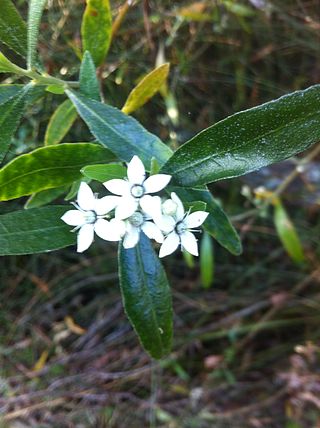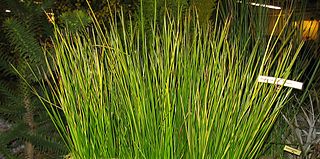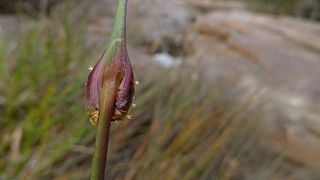
Acacia cyclops, commonly known as coastal wattle, cyclops wattle, one-eyed wattle, red-eyed wattle, redwreath acacia, western coastal wattle, rooikrans, rooikrans acacia, is a coastal shrub or small tree in the family Fabaceae. Native to Australia, it is distributed along the west coast of Western Australia as far north as Leeman, and along the south coast into South Australia. The Noongar peoples of Western Australia know the plant as wilyawa or woolya wah.

Acacia nigricans is a species of wattle which is endemic to an area on the south coast of Western Australia.

Acacia truncata, commonly known as the angle leaved wattle or west coast wattle, is a coastal shrub in the family Fabaceae, with a native distribution along the southwest coast of Western Australia. A specimen of this wattle was part of an early European botanical collection, perhaps the first from Australia.

Juncus acutus, the spiny rush, sharp rush or sharp-pointed rush, is a flowering plant in the monocot family Juncaceae. It is native to the Americas, Northern and Southern Africa, Western and Southern Europe and West Asia, and is found in a variety of wet habitats, such as bogs, fens, meadows, and salt marshes, and along the edges of ponds and lakes.

Acacia myrtifolia, known colloquially as myrtle wattle, red stem wattle or red-stemmed wattle, is a species of Acacia native to coastal areas of southern and eastern Australia.

Taxandria marginata is a species of shrub that grows in the south west corner of Western Australia. This plant was previously classified as Agonis marginata but was reclassified by Wheeler and Marchant into the new genus Taxandria in a 2007 revision.

Acacia merrallii, commonly known as Merrall's wattle, is a shrub belonging to the genus Acacia and the subgenus Phyllodineae that is endemic to south western and southern Australia.

Acacia triptycha is a shrub or tree of the genus Acacia and the subgenus Plurinerves that is endemic to an area of south western Australia.

Rhadinothamnus anceps, commonly known as blister bush, is a shrub belonging to the genus of Rhadinothamnus, which is endemic to Western Australia.

Xanthorrhoea brunonis is a species of grasstree of the genus Xanthorrhoea native to Western Australia.

Xanthorrhoea gracilis, commonly known as the graceful grasstree, grassboy or mimidi, is a species of grasstree of the genus Xanthorrhoea native to Western Australia.

Lobelia tenuior, commonly known as slender lobelia, is a small herbaceous plant in the family Campanulaceae native to Western Australia.
Baumea arthrophylla(now known as Machaerina arthrophylla) is a flowering plant in the sedge family, Cyperaceae that is native to many states and territories of Australia.

Machaerina juncea, commonly known as bare twig-rush or tussock swamp twig rush, is a sedge in the sedge family, Cyperaceae, that is native to Australia, New Zealand, and New Caledonia.
Baumea preissii is a flowering plant in the sedge family Cyperaceae, which is native to Western Australia.

Machaerina rubiginosa, commonly known as soft twig rush, flat leaf twig rush or common twig rush, is a flowering plant in the sedge family, Cyperaceae, that is native to Asia and the Pacific.
Baumea vaginalis, commonly known as sheath twig rush, is a flowering plant in the sedge family, Cyperaceae, that is native to Western Australia.
Carex tereticaulis, also known as basket sedge, is a species of sedge of the family Cyperaceae that is native to southern parts of Western Australia, southern parts of South Australia, southern and eastern parts of New South Wales as well as north western and central Victoria and Tasmania. The Koori peoples know the plant as Poong'ort.

Chorizandra cymbaria, commonly known as heron bristle rush or heron bristle sedge, is a sedge of the family Cyperaceae that is native to Australia.
Eleocharis acuta, commonly known as common spikerush or small spikerush, is a sedge of the family Cyperaceae that is native to Australia.















